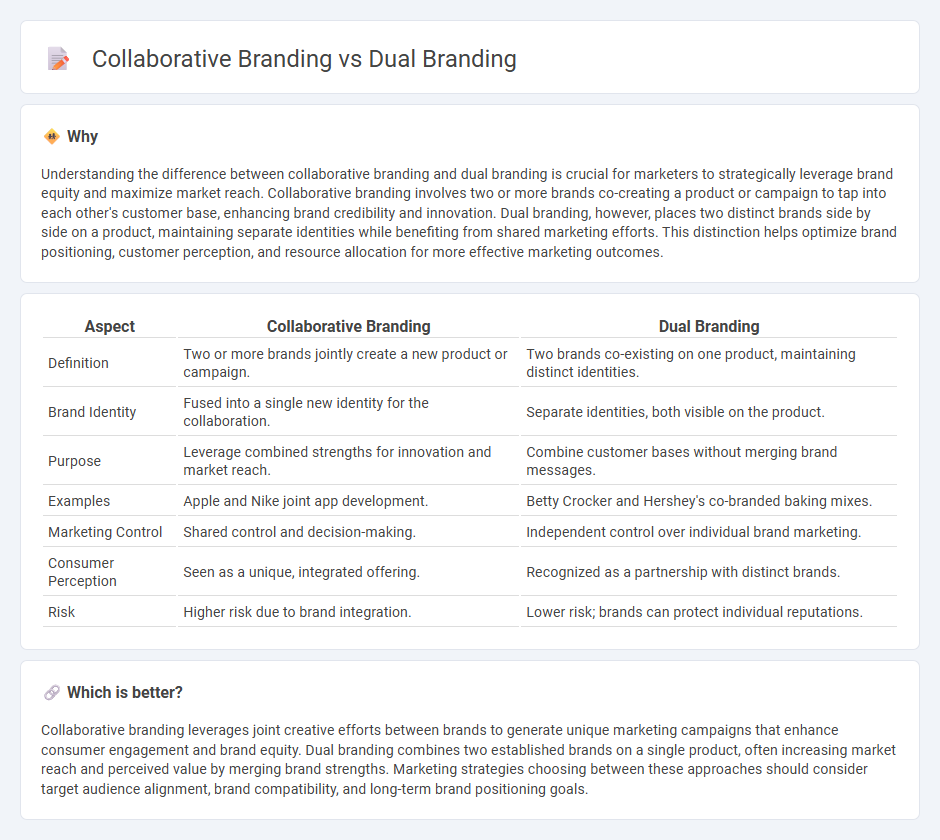
Collaborative branding merges the strengths of two or more brands to create a unique product or experience that leverages shared values and target audiences. Dual branding involves two distinct brands jointly marketing a single product while maintaining separate identities to boost recognition and credibility. Explore the strategic benefits and use cases of each branding approach to maximize market impact.
Why it is important
Understanding the difference between collaborative branding and dual branding is crucial for marketers to strategically leverage brand equity and maximize market reach. Collaborative branding involves two or more brands co-creating a product or campaign to tap into each other's customer base, enhancing brand credibility and innovation. Dual branding, however, places two distinct brands side by side on a product, maintaining separate identities while benefiting from shared marketing efforts. This distinction helps optimize brand positioning, customer perception, and resource allocation for more effective marketing outcomes.
Comparison Table
| Aspect | Collaborative Branding | Dual Branding |
|---|---|---|
| Definition | Two or more brands jointly create a new product or campaign. | Two brands co-existing on one product, maintaining distinct identities. |
| Brand Identity | Fused into a single new identity for the collaboration. | Separate identities, both visible on the product. |
| Purpose | Leverage combined strengths for innovation and market reach. | Combine customer bases without merging brand messages. |
| Examples | Apple and Nike joint app development. | Betty Crocker and Hershey's co-branded baking mixes. |
| Marketing Control | Shared control and decision-making. | Independent control over individual brand marketing. |
| Consumer Perception | Seen as a unique, integrated offering. | Recognized as a partnership with distinct brands. |
| Risk | Higher risk due to brand integration. | Lower risk; brands can protect individual reputations. |
Which is better?
Collaborative branding leverages joint creative efforts between brands to generate unique marketing campaigns that enhance consumer engagement and brand equity. Dual branding combines two established brands on a single product, often increasing market reach and perceived value by merging brand strengths. Marketing strategies choosing between these approaches should consider target audience alignment, brand compatibility, and long-term brand positioning goals.
Connection
Collaborative branding and dual branding both involve partnerships between two or more brands to leverage combined market strengths and consumer bases. Collaborative branding focuses on creating joint products or campaigns to enhance brand equity and reach new audiences. Dual branding pairs distinct brand identities within a single product offering to capitalize on the unique value and reputation of each partner.
Key Terms
Brand Identity
Dual branding involves two established brands maintaining distinct brand identities while jointly marketing a product, preserving their unique values and customer perceptions. Collaborative branding merges brand elements more closely to create a cohesive identity that leverages shared strengths and appeals to combined audiences. Explore deeper insights on how brand identity strategies shape the success of dual and collaborative branding efforts.
Partnership Structure
Dual branding involves two distinct brands maintaining their individual identity while co-marketing a product or service, often sharing resources and market influence. Collaborative branding integrates strengths from multiple brands into a unified approach, focusing on joint innovation and shared brand equity to create a new value proposition. Explore deeper insights into partnership structures to enhance your branding strategy choices.
Value Proposition
Dual branding leverages the combined strengths of two established brands to create a value proposition centered on enhanced product credibility and expanded customer reach. Collaborative branding prioritizes innovation and mutual brand enhancement by co-creating unique offerings that appeal to niche markets and foster deeper consumer engagement. Explore the specific benefits and strategic applications of each approach to optimize your brand value proposition effectively.
Source and External Links
Two Brands, One Drug: The Potential Benefits and Challenges of Dual Branding - Dual branding in pharmaceuticals is a strategy where one product is marketed under two different brand names to target different markets or uses, increasing market share and offering more patient options despite regulatory challenges.
Navigating Dual Branding: A Comprehensive Exploration - Dual branding involves two separate brands collaborating on a product or service to reach different market segments or leverage combined strengths, exemplified by partnerships like Nike and Apple or Starbucks and Spotify enhancing consumer experiences.
Dual branding vs co-branding? - Studio Noel - Dual branding creates separate brands for the same product/service to reach new audiences and foster brand growth and loyalty by offering diverse options under one umbrella, contrasting with co-branding which promotes a joint identity.
 dowidth.com
dowidth.com